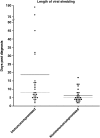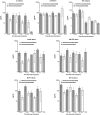The natural history of influenza infection in the severely immunocompromised vs nonimmunocompromised hosts
- PMID: 24186906
- PMCID: PMC3871797
- DOI: 10.1093/cid/cit725
The natural history of influenza infection in the severely immunocompromised vs nonimmunocompromised hosts
Abstract
Introduction: Medical advances have led to an increase in the world's population of immunosuppressed individuals. The most severely immunocompromised patients are those who have been diagnosed with a hematologic malignancy, solid organ tumor, or who have other conditions that require immunosuppressive therapies and/or solid organ or stem cell transplants.
Materials and methods: Medically attended patients with a positive clinical diagnosis of influenza were recruited prospectively and clinically evaluated. Nasal washes and serum were collected. Evaluation of viral shedding, nasal and serum cytokines, clinical illness, and clinical outcomes were performed to compare severely immunocompromised individuals to nonimmunocompromised individuals with influenza infection.
Results: Immunocompromised patients with influenza had more severe disease/complications, longer viral shedding, and more antiviral resistance while demonstrating less clinical symptoms and signs on clinical assessment.
Conclusions: Immunocompromised patients are at risk for more severe or complicated influenza induced disease, which may be difficult to prevent with existing vaccines and antiviral treatments. Specific issues to consider when managing a severely immunocompromised host include the development of asymptomatic shedding, multi-drug resistance during prolonged antiviral therapy, and the potential high risk of pulmonary involvement.
Clinical trials registration: ClinicalTrials.gov identifier NCT00533182.
Keywords: immunocompromised host; influenza; influenza A; stem cell transplant.
Figures



References
-
- WHO/UNAIDS/UNICEF. Global HIV/AIDS Response: Epidemic update and health sector progress towards Universal Access 2011. 2011.
-
- Lin JC, Nichol KL. Excess mortality due to pneumonia or influenza during influenza seasons among persons with acquired immunodeficiency syndrome. Arch Intern Med. 2001;161:441–6. - PubMed
Publication types
MeSH terms
Substances
Associated data
Grants and funding
LinkOut - more resources
Full Text Sources
Other Literature Sources
Medical

